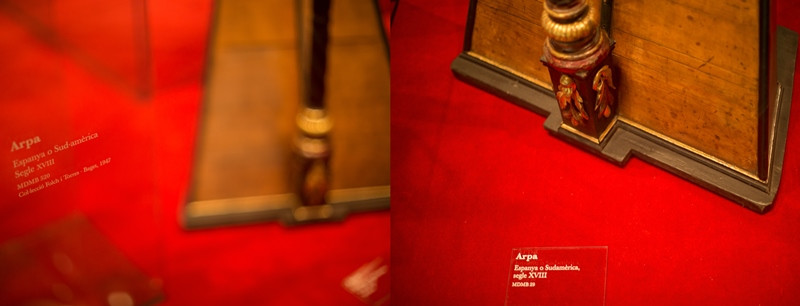
News
Lights, camera, labales... action!
On 7 June the Museu de la Música closed its doors to the public for 11 days to undertake several reforms that required continuous work and could not be done on Mondays alone. The closure has allowed us to carry out important interventions in the museum's infrastructure and also in museography:
- Change of lighting. From now on the entire museum has LED lighting. It is a technology widely consolidated in the museum field, clearly improving energy efficiency with less spending and zero heating. The new installation was carried out by our colleagues at the Scene Technical Department of L'Auditori, and thanks to that temperature standards were reasonably kept during this particularly hot summer..
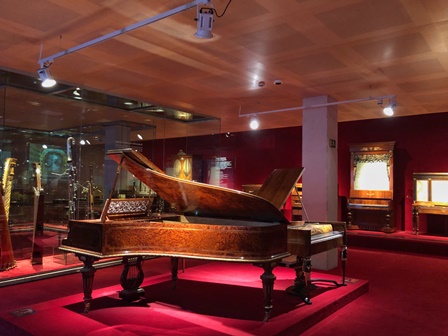
- Installation of a new security system. The reorganization of the internal tasks of the museum made essential to renew and update the security system after 12 years in L’Auditori. We changed the installation and placed new cameras, and security staff will now have much more efficient informatic tools.
- Renewal of the showcase 13. Once finished the exhibition 'The guitars of Quico Pi de la Serra' on June 7 we renewed the contents of showcase 13, previously dedicated to tradition and popular music. The new discourse follows this thread but with an explicit dialogue with the guitar showcase. The new space shows groups of instruments from traditional and popular music with the guitar as a link: the Mediterranean ‘rondallas’, jazz and swing from the 60s, current pop-rock, Latin American groups, United States country-folk, the Greek rebetiko and flamenco.
- Label renewal in the permanent exhibition. This is one of the most visible changes and it is a big improvement for several aspects of the exhibition. In this post we explain what, how and why.
Labels are printed elements normally accompanying a work on display in a museum. They usually contain information such as title, author, dating, provenance or materials used. The word comes from medieval Middle English ‘label’ (narrow band, strip of cloth) and from Old French ‘label’ or ‘lambel’, and also has many other meanings in areas such as computing, architecture or heraldry.
In the world of museography, labels are a very important element when imagining and designing an exhibition, either permanent or temporary. There are many decisions to make: label yes or no? If not, how is the technical information of each work transmitted? Which of this information is really necessary and relevant to the visitor? Which materials, colors and fonts are the most appropriate? What content, language and style criteria should be applied?
After more than a year of reflection, various tests and asking ourselves all these questions (and a few more), we renovated most of the labels in the permanent exhibition. The goals for this change are:
- Improve readability. Until now, labels were printed on vinyl cut to the glass of the showcases, and light reflection made reading difficult.
- Make the exhibition versatile as each instrument has its own label and now we can move and relocate it without having to repeat labels.
- Review errors and improve the identification of works on display. We reviewed contents, unifying criteria and better documenting our collections. A label style guide was created to establish guidelines for the future.
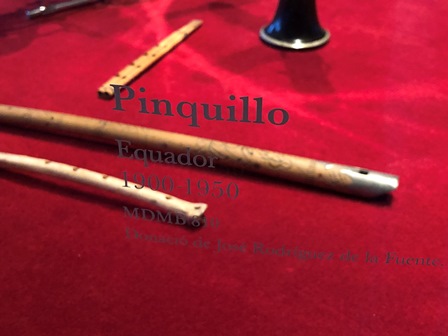
We understand that the label function is to identify the work through brief and descriptive information. There are often other contents (history of the instrument, origin, previous owners, pictures of the instrument in use) that we really want to tell and are very interesting for the visitors, but we believe they should be integrated into the exhibition through interpretative elements, such as field texts, audiovisuals, ambient music or audio-guide. Thus labels are identificative, not interpretative. This approach follows the current museographic lines and has been supported by specialists from Croquis, the company who advised, designed and produced the new labels.
The first step was to determine what labels had to be changed and which ones were left for a later renewal:
- Areas 2, 3, 5, 6, 7, 8, 11, 13, 14 and 15: completely renewed.
- Areas 9 and 10: we changed the labels for instruments located in the showcases.
- Area 12 (guitars): labels were changed in 2015. We now added two new labels for guitars recently displayed.
- Space 17 (Catalan musicians): new labels of the two grand pianos. In a later phase labels in the showcases will be revised.
We now have 402 new labels and 94 remain pending renovation.
As we said before, each instrument has its own label, but there are some exceptions: there are 3 labels called ‘group labels’. They refer to two or more instruments of the same type, displayed together and closely related by maker or date. Measures for individual labels are 10 x 15 cm and for group labels 10 x 30 cm. All of them are printed in white on glass using Baskerville font.

Regarding the content, the labels are written as follows:
Object Name - Grand piano
Authority - Chassaigne Frères
Place of execution, dating - Barcelona, 1915
Registration number - MDMB 1652
Provenance data - Donation of Carmen Bravo
The minimum fields are object name, dating and registration number. The rest do not appear if we do not know the information.
While working on each field contents we found different doubts, problems and decisions to make. Let's see some examples.
Object Name
As a general rule the label shows the vernacular name, that is, the name of instrument according to the individual, community, factory or geographic area that built it or used it. This name may or may not be the same that the name in our catalog, based on a thesaurus of standardized and controlled terms. For example, the pinquillo (MDMB 810) appears in the catalog as 'pincullo' (thesaurus term) but in the label we use 'pinquillo' since it is the most common name in Ecuador, the country where the instrument was made. In some cases we still use generic names in square brackets, when it was not possible to find out the vernacular name. This is the case of the Japanese aerophone MDMB 928, identified with the generic [recorder].

In the case of MDMB 846, vernacular name was not credited and the label showed the generic name ‘horn’. Now we have been able to identify the instrument as a Peruvian ‘waqra’, and this has led us to the possibility of having it mounted the other way around, since all the waqra referenced have a spiral form and this one does not.

Authority
The author of an instrument can be a person, a workshop, a family, a factory, a person who works with a pseudonym, a culture... or most likely: we cannot identify it. When renewing labels we added and review authors, for example in mvet MDMB 679 where we changed 'Attributed to Fang' to 'culture Beti' which is the denomination used by this African community to describe themselves. In the case of Tibetan instruments built in Nepal we incorporated 'Tibetan Culture' as an author to distinguish it.
Place of execution
It is the place where the instrument was built or manufactured. Our style guide is writing the current official name in Catalan and prioritizes geographical denominations before administrative ones. For example, we write New Guinea to indicate the island of New Guinea, although administratively half of the island belongs to Indonesia and the other half to Papua New Guinea.
We modified places that have changed their official name, for example in talam (MDMB 949) made in the Indian city of Orissa, now called Odisha. We also eliminated redundancies such as 'Barcelona, Catalonia, Spain' or 'Madrid, Community of Madrid'. Region, state or country are only written if the town is not widely known, or if there are several cities with the same name as in the United States. The Edison Bell phonograph (MDMB 373) is manufactured in Orange, New Jersey, but we can found Orange in Massachussetts, California, Connecticut, New Hampshire, Ohio, Texas, Vermont and Virginia.
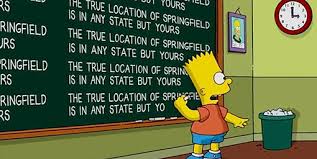
Provernance data
To honor donations as an act of generosity and contribution to the museum we include the provenance data only if it is a donation or a purchased work belonging to an important collection, such as Folch-Baget or Miquel Llobet’s collection. On the other hand, we eliminated the date of entry since we believe that it is confusing with the dating of the work, it is not a big contribution to the visitor experience and can be easily found in the online catalog.
Once the labels were printed, we placed them on the floor next to the instrument or in front of the pedestals following the recommended reading order: from top to bottom and from left to right.
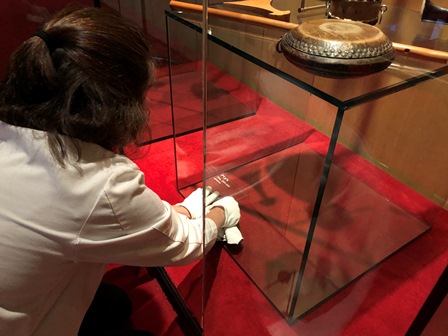
After a few months of testing the result is extremely positive. There are still a hundred labels to renew, but the improvement in reading and the flexibility of the exhibition encourage us to continue. We look forward to your comments and reflections on the new labels to help us improve!

